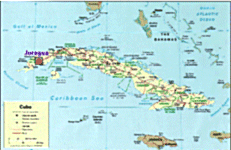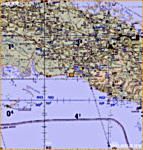
 |
FAS | Nuke | Guide || Join FAS |
Cuba Special Weapons
Cuba does not possess nuclear weapons, and there are no credible reports of Cuban efforts to acquire nuclear weapons. Cuba is not reported to possess chemical weapons, nor are there credible reports of Cuban possession of long range ballistic missiles. Cuba is generally regarded as having a program of research on biological warfare agents, though the scope and focus of this effort remains obscure and controversial.
In 1990, Cuba's air force, with approximately 150 Soviet-supplied fighters, including advanced MiG-23 Floggers and MiG-29 Fulcrums, was probably the best equipped in Latin America. In 1994, Cuba's armed forces were estimated to have 235,000 active duty personnel. Cuban military power has been sharply reduced by the loss of Soviet subsidies. By 1999 the Revolutionary Armed Forces numbered about 60,000 regular troops. As of 2010, the Central Intelligence Agency (CIA) World Factbook states that despite lacking replacement parts for its existing equipment, the Cuban military was still well trained and capable.
Nuclear Weapons
Tensions between the United States and Cuba peaked during the abortive "Bay of Pigs" invasion by anti-Castro Cubans supported by the United States on April 7, 1961. Taking advantage of Cuba's fear of further American armed aggression, the Soviets persuaded the Cubans into closer economic and political links including military and defense arrangements. In the fall of 1962, there were unconfirmed reports that the Soviets were installing intermediate-range nuclear missiles in Cuba. When evidence confirmed these reports, the resulting confrontation between Soviet Premier Nikita Khrushchev and US President John F. Kennedy in October 1962 brought the world to the brink of war.
Cuba did not become a party to the Nuclear Non-Proliferation Treaty (NPT) until November 4, 2002. Cuba signed the Treaty of Tlatelolco on March 25 1995, a Latin American regional non-proliferation regime, but did not ratify the Treaty until October 23, 2002. At the time of its ratification, Cuban leadership stated that Cuba’s adherence to the Treaty of Tlateloco was preconditioned on Cuba’s hostile relations with the United States. Cuba routinely abstains in UN General Assembly votes on resolutions on a wide range of disarmament and international security issues. Cuba has entered into an agreement with the International Atomic Energy Agency (IAEA) to apply safeguards to individual nuclear facilities, including the partially completed Juragua nuclear power plant. The reactors that were to be installed were of the VVER-400 type, an advanced model of the Soviet pressurized water reactor. There were serious concerns about the safety of the plant. However, the plant did not appear to be economically viable, and no international investors were willing to provide funds for completion of the facility. During Vladimir Putin’s presidential visit to Havana in December 2000, both Russia and Cuba agreed to abandon the Juragua nuclear power plant project.
Cuba has been a signatory to the NPT since 2002. Cuba's historical position towards the NPT proceeded from a view that the technical assistance aspect of the IAEA's activities had not produced so many benefits as the nuclear safeguards aspect, which implied a notable imbalance in the Agency's different sectors. And while IAEA efforts regarding safeguards are gathering strength, Cuba's position was that the fragility of the then-current nuclear non-proliferation regime could only be corrected through the complete elimination of nuclear arms.
The IAEA spent about $12 million on nuclear technical assistance projects for Cuba from 1963 through 1996. About three-quarters of the assistance consisted of equipment, such as computer systems, and radiation-monitoring and laboratory equipment. In 1997 the IAEA approved an additional $1.7 million for nuclear technical assistance for Cuba through 1999. Most of IAEA's assistance projects were funded through the agency's technical cooperation fund, which is supported by member states' voluntary contribution. From 1981 through 1995, the United States withheld about $2 million from its voluntary contribution that otherwise would have gone for nuclear technical assistance for Cuba. Of the total dollar value of all projects IAEA has provided for Cuba, about $680,000 was approved for nuclear safety assistance for Cuba's nuclear power reactors from 1991 through 1998. US officials did not object to IAEA providing nuclear safety assistance to Cuba's reactors because the United States generally supports nuclear safety assistance.
Construction of the Juragua nuclear power plant began in 1983, as the result of a 1976 Soviet-Cuban agreement. Analysts estimate that the plant could reduce Cuba's imported fossil fuel dependence by a quarter. The plant is located in Cienfuegos province, 250 kilometers from Havana. Construction of the two 440 MW WWER 440 PWR reactors was suspended in 1992 when Russia terminated its substantial support for Cuba. As of 1995 Unit-1 was about 80% complete and would take about 2 years to finish. Unit-2 was about 50% completed. Efforts by the Castro regime to preserve the uncompleted structures continued at a cost of $2 million to $3 million per year. However, no source of funding for the $750 million needed to complete the work was available. The US General Accounting Office reported serious safety problems with the reactors. The safety problems with the plant were associated with poor construction, poor quality-control, lack of Western safety and control equipment, and a poor regulatory program in Cuba.
In the aftermath of the Chernobyl accident, representatives of over 50 nations participated in the development of a Convention on Nuclear Safety, a multilateral treaty that seeks to increase the safety of civil nuclear power reactors. Although Cuba does not yet have any operating nuclear power reactors, it is a signatory to this convention.
President Clinton stated in April 1993 that the United States opposed the construction of the Juragua nuclear power plant because of the concerns of the United States about Cuba's ability to ensure the safe operation of the facility and because of Cuba's refusal to sign the NPT or ratify the Treaty of Tlatelolco. Under the provisions of the Cuban Liberty and Democratic Solidarity (Libertad) Act of 1996, "the completion and operation of any nuclear power facility ... will be considered an act of aggression which will be met with an appropriate response in order to maintain the security of the national borders of the United States and the health and safety of the American people." The United States government's policy was that sales or assistance to the Cuban nuclear program should not be provided until Cuba has undertaken a legally binding non-proliferation commitment, including a commitment to accept International Atomic Energy Agency safeguards on all present and future nuclear facilities.
Cuba has sought to boost its oil production in response to severe energy shortages since the collapse of the Soviet Union, which put an end to barter arrangements under which Cuba had access to relatively inexpensive oil supplies. About two-thirds of total domestic consumption comes from imported oil. Cuban oil production comes mainly from fields discovered in the 1960s and 1970s, when state oil company Cubapetroleo (Cupet) conducted limited exploration. Refineries process imported crude oil mainly from Venezuela and Mexico. Some oil is imported under an oil-for-sugar arrangement with Russia. Most domestic production consists of heavy oil whose sulfur content is so high that it can only be used for converted power and cement plants. The Cuban government estimates that oil production in early 1999 increased by 23% over the same period in 1998.


Sources and Resources
- Cuba's Pursuit of Biological Weapons: Fact or Fiction?, hearing before the Senate Foreign Relations Committee, June 5, 2002 [PDF]
- Cuba's Nuclear Reactors at Juragua US DOE Energy Information Administration September 2, 1999 - The United States has expressed concerns about safety and opposes completion of the reactors.
- Russia and Cuba Agree to End Juragua Nuclear Power Plant Project, Patrick E. Tyler, New York Times, December 18, 2000, last accessed May 30, 2012
- Release Regarding Cuba's Acceding to the NPT and Treaty of Tlatelolco, Arms Control Association, December 2002, last accessed May 30, 2012